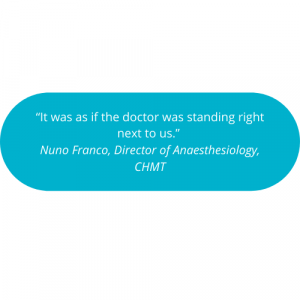When it comes to teaching and learning surgical procedures, there’s only so much space in the operating room (OR). So what if you could be present without being in the room?
Innovative digital technology from Rods&Cones is helping medical professionals to connect safely from anywhere in the world, in real-time.
Whether they’re located in the next room, a different hospital, a medical school, or even in the comfort of their own home on the other side of the globe, students, physicians, and assisting surgeons are leveraging the educational benefits of remote surgical assistance technologies.
Using a combination of smart surgery glasses and a digital remote access platform, technology is opening up secure video and audio access to the OR and creating the potential to democratize the best medical skills, expertise, and advice worldwide.
Let’s take a closer look at three ways this innovative technology is being utilized by leading medical practitioners to enhance training and education in hospitals.
Remote resident training
In 2019, gynecologists Dr. Martine Wassen and Dr. Nicol Smeets became the first surgeons in the Netherlands to use a new surgical procedure known as Natural Orifice Transluminal Endoscopy Surgery (NOTES). This procedure is a minimally invasive surgical technique that uses natural orifices of the human body to get access to the abdominal cavity.
When they performed a Vaginal Assisted NOTES Hysterectomy in 2021, this revolutionary technique was broadcasted in real-time and high-definition video to multiple residents at the Zuyderland Medical Centre using Rods&Cones technology.
With a more complete view of the operation, the residents were able to ask questions and communicate directly with the surgeon through the remote surgical assistance platform, which enabled a complete visual and auditory connection between the viewers and the surgeon.
Learning from the broadcasting of this technique has created the potential to dramatically improve patient outcomes, resulting in decreased scarring, post-operative pain, shorter hospital stays, and fewer complications.
This is just one example of how diagnostic imaging can be broadcasted to surgeons and residents to continuously improve patient outcomes, facilitating the sharing of the newest techniques, and positively impacting millions of patients.
Dental surgery boot camp
Earlier this year, a Dental Bootcamp was held in the Van der Valk Hotel in Ghent, Belgium. During the ‘Crown-Guide Bootcamp’, the audience was able to remotely follow a live single dental implant and immediate loading procedure from a conference room at the hotel.
Performed by periodontists Guillaume De Moyer and Valentin Vervack, the procedure utilized Rods&Cones devices to remotely connect with the audience during the dental operation, which included the use of a Straumann Bone level implant to successfully complete the procedure.
Broadcasting the procedure in this way enabled a room full of dental professionals to learn how to successfully plan for this operation, including how to create the provisional crown, and how to perform the implant step by step. Watching the surgery live on a large high-definition screen with audio gave a much clearer picture of the procedure than if they were actually standing alongside the surgeons in the theatre itself.

Peer-to-Peer consultation
When leading anaesthesiologists at the Centro Hospitalar do Médio Tejo (CHMT) introduced an innovative new anaesthesia procedure, they used Rods&Cones digital technology to provide professional assistance from outside the OR.
This minimally invasive anaesthetic technique is an alternative to general anaesthesia, which in the case of heart patients – especially vulnerable ones – is an undeniable asset with the potential to save many lives. While Nuno Franco’s team was operating in Portugal, a professional expert located thousands of miles away in Austria was giving them exact instructions on how to successfully implement the anaesthesia.
The future of surgical training and education
As these three examples show, remote access to the OR is giving medical practitioners a better view of surgical procedures and helps to enhance surgical training and education. By connecting experts, students, and physicians in real-time with the OR, surgical assistance technology from Rods&Cones is helping to educate surgeons on new procedures and enable the surgical workforce to share best practices on a global scale.
Now, surgeons across the globe can invite peers and students into any OR to follow a procedure in real-time. Medical students can witness live surgical procedures, while experienced peers advise and comment during live surgery. And when those same students are performing surgery for the first time, they can access hand-on-your-shoulder mentoring, as a more experienced colleague guides their work remotely.
Whether it’s communication with a colleague, or expert advice from a senior surgeon, connected remote video technology from Rods&Cones enables medical professionals to get timely support whenever they need it. That also means surgeons in remote areas of the world can connect with international experts for real-time guidance during complex procedures.
From existing surgeons learning a new procedure to students completing their medical qualifications, learners can now view procedures from a first-person perspective, not from a 90-degree angle to the surgeon.
Find out more about using Rods&Cones technology for surgical training and education in hospitals and medical schools.

